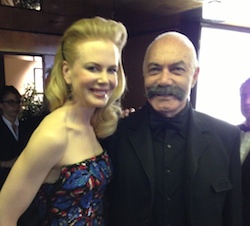One of the year’s best and most relevant features, I Am Not Your Negro was just voted Best Documentary-Non-Fiction by the L.A. Film Critics Association.

When director Raoul Peck first met Gloria Karefa-Smart, James Baldwin’s sister and executor of the Estate, one of the first items she gave him was a letter written by her brother to his literary agent Jay Acton, in which he informs him of his decision to write, as his next book, and possibly his last: “Remember This House.”
For the next ten years, Peck had the rights to Baldwin’s entire body of work. He knew that he wanted to bring Baldwin to the screen, even if it would be a painful and complex endeavor.

Initially, he planned to create, as with his project Lumumba, a narrative film and a documentary. After several unsuccessful runs in Hollywood to get the project into development, he decided to concentrate on producing the documentary first. But he wasn’t sure how to go about this.
Then one day, Gloria, gave him a pile of neatly (and partly crossed out) typewritten pages and a letter. “You’ll know what to do with this,” she said. That was it, the film to be: To assume that the book did exist. It was buried everywhere in Baldwin’s body of work and public presentations. Our job was to find it and recreate it from all the pieces.
Peck’s intent with I Am Not Your Negro is to lead viewers along the complex political road of the “memorable” lives of Malcom, Medgar and Martin, using only Baldwin’s own words, and leaning heavily on the text of Remember This House.

I Am Not Your Negro bears some resemblance to Celluloid Closet and Concerning Violence in pulling still and moving images from a variety of sources to weave an immersive audiovisual tapestry. There are images of the young black Dorothy Counts confronting a large, aggressive, white mob by herself on her way to attend her first day of school, and Peck’s peculiar analysis of Guess Who’s Coming to Dinner? and Sidney Poitier’s role in Hollywood cinema.
Why James Baldwin?
James Baldwin (1924-1987) was one of the greatest American writers of the second half of the twentieth century. He was raised in Harlem and, at age 24, frustrated by the state of race relations in America and regular incidences of harassment, left the U.S. for France where he lived for most of the rest of his life.
A prolific writer and brilliant social critic, he foreshadowed the destructive trends happening today in the western world, while always maintaining a sense of humanistic hope and dignity. He explored palpable yet unspoken intricacies of racial, sexual, and class distinctions in Western societies and the inevitable if unnamable tensions with personal identity, assumptions, uncertainties, yearning, and questing. He had an unrivaled understanding of politics and history, and above all, the human condition.

Why Now?
Today James Baldwin’s words still bear the same violent truth. There will hardly ever be anything as precise, as just, as subtle, as more percussive, than the writing of this man, who understood all: politics, history, and most of all, the human factor.
Baldwin survived the magicians, the gurus and the smooth talkers of his time, black or whites. His thoughts are as effective today as when they were first expressed. His analysis, his judgment, his verdicts are even more percussive today than when originally written.

In today’s context of extreme violence in America, especially against blacks, I Am Not Your Negro attempts to analyze and understand the deeper structural explanation, or as Peck puts it: “Despite progress, Martin seems quite lonely on the mountain top.”
The cycles of violence and confusion condemned by Baldwin have prevailed–trivialized and distorted by the influence of the press, television, Hollywood, and angry partisan politics.
How do we break these cycles when we never touch the real issues themselves? How do we address the fundamental problems of America? Never before has Baldwin’s voice been so needed, so powerful, so radical, so visionary.


Dramatic Construction
I Am Not Your Negro reclaims James Baldwin’s quest, through which Peck also re-appropriates his own story. It is James Baldwin’s words that viewers hear, but it is Peck’s own experience, his emotional syntax that provides the film’s structure, rhythm, and turning points.
By documenting these three ‘memorable’ lives (Evers, King, Malcolm), Peck also dissects Obama’s America and revisit the central argument of the “Negro problem in America.” Obama unfortunately did not erase the dominant storyline. The brief euphoria of Obama’s emergence did not heal all wounds of a country built on blood.
Against Obama’s undeniable presence, Peck sets the reality, no less essential, of decades of myths and one-sided storytelling. For Peck, “Despite any real or perceived ‘progress,’ we cannot avoid questioning the accuracy of the new symbols of change.”

Subjective Approach
Inspired by filmmakers such as Chris Marker, Alexander Kluge, and even Godard, Peck returns to his roots as a filmmaker (i.e. Lumumba, death of a prophet). For him it was a time when innocence allowed to take risks, when political and aesthetic experimentation had few limits, when there was no model, no margin, no mark, and no dogma that couldn’t be pulverized. His goal was to “question everything again and reclaim my freedom and my subjectivity.”
The result is a rare experiment with words, form, images, music, humor, poetry and drama that captures the harsh reality of violence, rape, racism, exploitation, abuse, massacre and injustice.
Voice of Baldwin, Narrated by Jackson
To speak these words, Peck needed a “personality,” a familiar voice that would not distract from the essential, so he chose Samuel L. Jackson who embraced the film and its approach.
Images
Primarily visual and musical, I Am Not Your Negro uses archival images from private and public photos; film clips, Hollywood classics, documentaries, film and TV interviews, popular TV shows, TV debates, public debates and contemporary images. It is a kaleidoscope, featuring a frantic and poetic assemblage (a medley), all in Baldwin’s very own, peculiar style.
The images punctuate the words and the music and vice versa. By revisiting the traditional “Black” iconography, with its clichés, the unspoken, the fundamental errors of interpretation and even the paternalistic prudery, I Am Not Your Negro redefines their meaning and impact.
Peck summed up his experience: “For a project like this one, a lot of patience, time and risks are involved. And at the early stage it’s almost impossible to convince anyone about the film. Then after a lot of research, writing and editing comes a time when what you really need above all is: trust.”
It was ITVS and executive producer of Independent Lens, Lois Vossen, who came at the right time, with courage, conviction, and funding.










